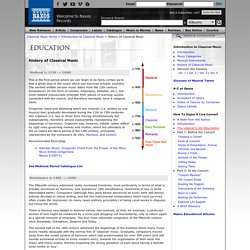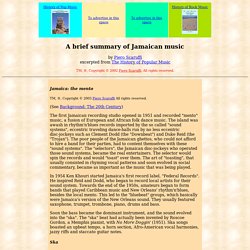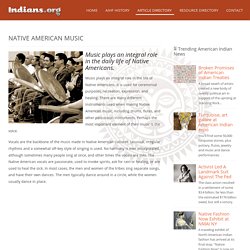

Tor
African music.
01track0. African music. History of Classical Music - Eras. This is the first period where we can begin to be fairly certain as to how a great deal of the music which has survived actually sounded.

The earliest written secular music dates from the 12th century troubadours (in the form of virelais, estampies, ballades, etc.), but most notated manuscripts emanate from places of learning usually connected with the church, and therefore inevitably have a religious basis. Gregorian chant and plainsong which are monodic (i.e. written as one musical line) gradually developed during the 11th to 13th centuries into organum (i.e. two or three lines moving simultaneously but independently, therefore almost inadvertently representing the beginnings of harmony). Organum was, however, initially rather stifled by rigid rules governing melody and rhythm, which led ultimately to the so-called Ars Nova period of the 14th century, principally represented by the composers de Vitry, Machaut, and Landini. Recommended Recording: Recommended Recordings: Cajun Music - Crowley Two Step. Dewey Balfa at left with Eli Stutes performing in the LSUE Acadian Center in 1979 a few months after the tragic death of Dewey's brothers, Rodney and Will, in a highway accident.

The Balfa Brothers have been described as the "quintessential Cajun band. " Vinesse LeJeune on fiddle and Alphonse "Bois Sec" Ardoin on accordion with Canray Fontenot behind them performing in the LSUE Acadian Center in 1979. Different versions of these musical subgenres like Cajun-country continue until this day, but one more development is of crucial importance in shaping Cajun music. In 1964, Gladius Thibodeaux, Louis "Vinesse" LeJeune, and Dewey Balfa (who joined as a last minute replacement playing guitar) accepted an invitation to represent Louisiana performing traditional Cajun music at the Newport Folk Festival.
After their performance, they received a standing ovation. Multicultural Folk Dance 2:51 by The Music Bakery. The Roots of Tejano and Conjunto Music. Arhoolie RecordsMusic Excerpts, Liner Notes, and Photos All music excerpts, liner notes, and photos on this page are the property of: Arhoolie Records, 10341 San Pablo Av., El Cerrito, CA 94530 The roots of Tejano and Conjunto music are as widespread and diverse, and run as deep, as the traditions, cultures and people which gave them life.

The main root is the music of Mexico with all its regional and class variations, its extraordinary range of songs and dances, and its social and religious musics ranging from the solo voice to the powerful sound of the bandas from Sinaloa to the highly stylized format of today's mariachis. Salsa Music Dance Videos. Salsa Music History. The salsa music history goes a long way back.

In the 1940’s this style of music was knows as Afro-Cuban Jazz. This Afro-Cuban jazz was played mainly in New York by immigrants from Puerto Rico. It was mainly due to embargo on Cuba starting in the 1960’s that the musicians needed a different name for there music as Afro-Cuban was no longer an option because it related to Cuba. This is when they the term Salsa was introduced. Fania Records By the 1970s, numerous artists joined Fania Records. Diversification The 1980s was a time of diversification. Today we also have Latin Houses which is inspired on salsa rhythms. Bob Marley - Could You Be Loved Music Video & Lyrics - Music Videos.
A History of Reggae Music. Jamaica: the mento TM, ®, Copyright © 2003 Piero Scaruffi All rights reserved.

(See Background: The 20th Century) The first Jamaican recording studio opened in 1951 and recorded "mento" music, a fusion of European and African folk dance music. The island was awash in rhythm'n'blues records imported by the so called "sound systems", eccentric traveling dance-halls run by no less eccentric disc-jockeys such as Clement Dodd (the "Downbeat") and Duke Reid (the "Trojan"). The poor people of the Jamaican ghettos, who could not afford to hire a band for their parties, had to content themselves with these "sound systems".
In 1954 Ken Khouri started Jamaica's first record label, "Federal Records". Native american music II. Native American music and culture. Music plays an integral role in the daily life of Native Americans.

Music plays an integral role in the life of Native Americans. It is used for ceremonial purposes, recreation, expression, and healing. There are many different instruments used when making Native American music, including drums, flutes, and other percussion instruments.